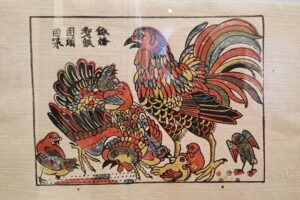In 1804, King Gia Long issued a decree making Vietnam the official national title of the beautiful country. So, what does Vietnam mean?
In the article, there is also more detailed information to study this name, including:
- The meaning of Vietnam’s national name
- History of establishing Vietnam
- Different names of Vietnam in history
- Conclusion
If you want to understand the meaning of the national title quickly, please read the 1st and 4th sections. If you like to dig deeper, please follow the article order from top to bottom to get a full view.
Now, please begin studying the main section!
1. Meaning of the national name
1.1. Vietnam means the Vietnamese in the Southern Land
This explanation is widely accepted and used when talking about the national name of Vietnam. Accordingly, “Viet” refers to the entire collection of 54 ethnic groups living in the territory. In particular, the Kinh group accounts for the majority, so this group is also called the Viet ethnic group. “Nam” is understood as the southern land.
Therefore, when combining these two words, Vietnam has the same meaning: The Vietnamese have settled and lived in the southern land.
1.2. Another explanation of the meaning
There are other debates about the meaning of the country’s national name.
Vietnam means unity, compounded by two words: “Viet Thuong” and “An Nam.”
Viet Thuong refers to an ethnic group or a small country in the southern part of China. It does not have many historical records, and its explanations are vague and unclear.
Nam is taken from the words “An Nam” or “Annam.” Annam refers to a peaceful land in the southern area of China. During the feudal period, the French called the central region of Vietnam Annam, ruled by the Nguyen Dynasty.
Many think this is a mechanical explanation, lacking any factual basis. Therefore, plenty of people have differing views on this method of explanation.
In the framework of this article, we use that idea for reference. For the editor, we favor the explanation of the first opinion.
Attentively, the Vietnamese do not accept the name “Annam.” It’s because, from a cultural and historical point of view, this name suggests a lousy meaning and needs to be removed.[6]
2. History of Vietnamese National Names
The national title “Vietnam” was officially used in 1804 under King Gia Long (1802-1820) of the feudal Nguyen Dynasty (1802-1945).
Since then, this national name has been quickly admitted in official documents and has become the standard name in international trade and relationship activities. The establishment of the Vietnamese national title shows the autonomy and independence of the country.
However, before that, the word “Viet Nam” appeared in some historical documents of the country:
- In the 14th century, the word “Viet Nam” was mentioned right in the title of the book “Viet Nam The Chi” compiled by Academician Ho Tong Thoc [1]. This evidence reveals to improve the assertion that this national name had been around for a long time.
- In the 15th century, Nguyen Trai’s book “Du Dia Chi” mentioned “Viet Nam” [1], further confirming that this crucial national title was known.
- In the 16th and 17th centuries, the two words “Viet Nam” were also found on the inscriptions in ancient Vietnamese temples, including Bao Lam pagoda (1558) in Hai Duong, Cam Lo pagoda stele (1590) in Hanoi, and Phuc Thanh pagoda stele ( 1664) in Bac Ninh [1,3]. Again, this further confirms the use of this national name.
However, after ascending the throne in the early 19th century, King Minh Mang (1820-1840) changed the country’s name to “Dai Nam,” so the name “Viet Nam” was rarely used in popular documents under his reign. [2]
From the late 19th century to the early 20th century, the name “Vietnam” appeared more frequently in documents and the names of political organizations.
On September 2nd, 1945, the country’s name officially appeared in President Ho Chi Minh’s declaration of independence: the Democratic Republic of Vietnam (Việt Nam Dân chủ cộng hòa).
In 1976, at the first session of the 6th National Assembly, it was decided to change the country’s name to The Socialist Republic of Vietnam. [3]
The short name “Vietnam” or “Viet Nam” is still commonly used by the public nowadays.
3. The different names of Vietnam in history
Over thousands of years of development, the country’s national name has changed many times. The following is a list of its names with the same period for comparison.
- Van Lang – Hung Vuong King (7th – 2nd century BC)
- Au Lac – An Duong Vuong (from 257 to 208 BC)
- Van Xuan – Ly Nam De (544 – 602)
- Dai Co Viet – Dinh, Former Le to Ly (968 – 1054)
- Dai Viet – Ly and Tran (1054 – 1400)
- Dai Ngu – Ho Quy Ly (1400 – 1407)
- Dai Viet – (Later Le to) Tay Son (1428 – 1802)
- Vietnam – Nguyen Dynasty (1802 – 1945); during the reign of Minh Mang King (1820 – 1840), it was known as Dai Nam.
- The Democratic Republic of Vietnam – 1945 to 1976
- The Socialist Republic of Vietnam – 1976 to present. Vietnam for short. [4,5].
4. Conclusion
As explained and agreed by the public, the national name of Vietnam means the Vietnamese people living in the South to distinguish it from the territory and many groups in the North.
Along with the meaningful name of this small and beautiful country are a diverse landscape and friendly people waiting for you to explore.
Notes in Vietnamese to research:
[1] https://baoquangnam.vn/chinh-tri/quoc-hieu-viet-nam-co-tu-khi-nao-53265.html
[2] https://mocban.vn/ban-khac-co-nhat-ve-su-kien-vua-minh-mang-doi-va-dat-ten-ha-noi-nam-1831/
[3] https://pbgdpl.tayninh.gov.vn/tai-lieu-tuyen-truyen/ngay-02-7-1976-nuoc-ta-doi-quoc-hieu-tu-viet-nam-dan-chu -cong-hoa-thanh-cong-hoa-xa-hoai-chu-nghia-viet-nam-343.html
[4] http://www.thanhdoan.hochiminhcity.gov.vn/ThanhDoan/webtd/News/1384
[5] http://vtec.edu.vn/index.php?option=com_content&view=article&id=665
[6] https://plo.vn/doanh-nghiep-bi-cam-dat-ten-nhay-cam-post54409.html




